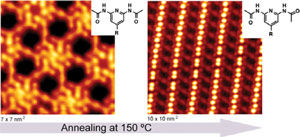Cleaner diesels thanks to laser light
Measuring soot formation in a diesel engine is far from easy. Due to the turbulent environment in the combustion cylinder, no two combustion cycles are the same. Furthermore, the measurements are difficult to reproduce as the pressure at which fuel is injected into the cylinder causes an extra source of turbulence. Bougie made his measurements in a glass cylinder with an engine adapted for this purpose.
Laser Induced Incandescence (LII) can be used to investigate optimal engine conditions that reduce soot emission from the engine. LII can be deployed in different types of engines and with different fuels. Bougie carried out measurements during higher and lower loading of the engine and for two different fuel injection systems: a line pump system and a common rail system. Neither the engine load nor the injection system was found to affect the primary particle size of the soot emitted. However, there are many other motor settings that can lead to an improvement in the combustion.
The results of the measurements can now be used to verify existing combustion models at Eindhoven University of Technology. Together with the STW users' committee (participants are: DAF, Eindhoven University of Technology, Delft University of Technology, the University of Twente, Cyclone Fluid dynamics, EP Controls BV, Paul Scherrer Institute (Villigen, Switzerland), Royal Netherlands Naval College, TNO and Shell), Eindhoven University of Technology will investigate further improvements to the measuring system with the ultimate objective of producing cleaner diesel engines.
Most read news
Organizations

Get the analytics and lab tech industry in your inbox
By submitting this form you agree that LUMITOS AG will send you the newsletter(s) selected above by email. Your data will not be passed on to third parties. Your data will be stored and processed in accordance with our data protection regulations. LUMITOS may contact you by email for the purpose of advertising or market and opinion surveys. You can revoke your consent at any time without giving reasons to LUMITOS AG, Ernst-Augustin-Str. 2, 12489 Berlin, Germany or by e-mail at revoke@lumitos.com with effect for the future. In addition, each email contains a link to unsubscribe from the corresponding newsletter.























































